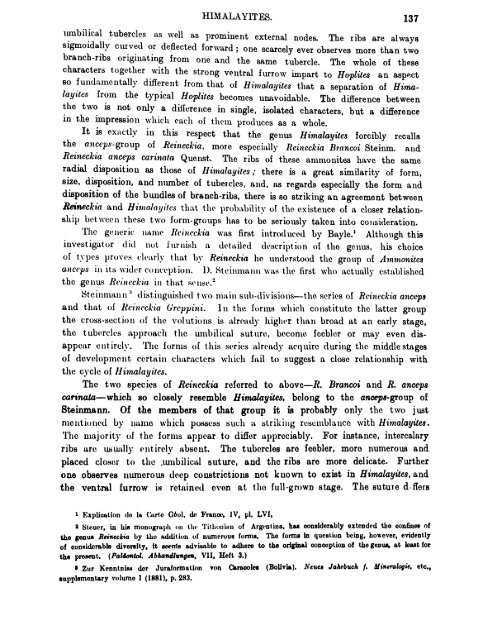Ser. XV. HIMALAYAN FOSSILS, Vol. IV. THE FAUNA OF THE SPITI ...
Ser. XV. HIMALAYAN FOSSILS, Vol. IV. THE FAUNA OF THE SPITI ...
Ser. XV. HIMALAYAN FOSSILS, Vol. IV. THE FAUNA OF THE SPITI ...
You also want an ePaper? Increase the reach of your titles
YUMPU automatically turns print PDFs into web optimized ePapers that Google loves.
HIMALAYITES. 137<br />
umbilical tubercles as well as prominent external nodes. The ribs are always<br />
sigmoidally curved or deflected forward ; one scarcely ever observes more than two<br />
branch-ribs originating from one and the same tubercle. The whole of these<br />
characters together with the strong ventral furrow impart to Hoplites an aspect<br />
so fundamentally different from that of Himalayites that a separation of Himalayites<br />
from the typical Hoplites becomes unavoidable. The difference between<br />
the two is not only a difference in single, isolated characters, but a difference<br />
in the unpression which each of them produces as a whole.<br />
It is exactly in this respect that the genus Himalayites forcibly recalls<br />
the (weeps-group of Reineckia, more especially Reineckia Brancoi Steinm. and<br />
Reineckia anceps carinata Quenst, The ribs of these ammonites have the same<br />
radial disposition as those of Himalayites; there is a great similarity of form,<br />
size, disposition, and number of tubercles, and, as regards especially the form and<br />
disposition of the bundles of branch-ribs, there is so striking an agreement between<br />
Reineckia and Himalayites that the probability of the existence of a closer relationship<br />
between these two form-groups has to be seriously taken into consideration.<br />
The generic name Reineckia was first introduced by Bayle. 1 Although this<br />
investigator did not furnish a detailed description of the genus, his choice<br />
of types proves clearly that by Reineckia he understood the group of Ammonites<br />
anceps in its wider conception. D. Steinmann was the first who actually established<br />
the genus Reineckia in that sense. 2<br />
Ste inmann' 1 distinguished two main sub-divisions—the series of Reineckia anceps<br />
and that of Reineckia (Jrcppini. In the forms which constitute the latter group<br />
the cross-section of the volutions is already higher than broad at an early stage,<br />
the tubercles approach the umbilical suture, become feebler or may even disappear<br />
ent irely. The forms of this series already acquire during the. middle stages<br />
of development certain characters which fail to suggest a close relationship with<br />
the cycle of Himalayites.<br />
The two species of Reineckia referred to above—R. Brancoi and R. anceps<br />
carinata—which so closely resemble Himalayites, belong to the anceps-group of<br />
Steinmann. Of the members of that group it IB probably only the two just<br />
mentioned by name which possess such a striking resemblance with Himalayites.<br />
The majority of the forms appear to differ appreciably. For instance, intercalary<br />
ribs arc usually entirely absent. The tubcrcles are feebler, more numerous and<br />
placed closer to the .umbilical suture, and the ribs are more delicate. Further<br />
one observes numerous deep constrictions not known to exist in Himalayites, and<br />
the ventral furrow is retained even at the full-grown stage. The sutuie d ffers<br />
1 Explication do In Curtc GAol. do Frnaoc, <strong>IV</strong>, pi. LVI,<br />
* Stcuer, in his monograph on the Tithoniim of Argentina, has considerably extended tbo confines of<br />
the genua Reineckia by the addition of numerous form*. The forms in question being, however, evidently<br />
of considerable diversity, it sccrrfs advisablo to adhere to the original oonceplion of the genus, at least for<br />
the present. (PoUontol. Abhandlvngen, VII, Heft 3.)<br />
a 2«r Kenntniiw dor Juraformation von Caraoolcs (Bolivia). Ntuea Jahrbueh f. Uineratogie, eto,,<br />
supplementary volumo I (1881), p. 283.

















